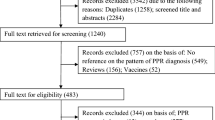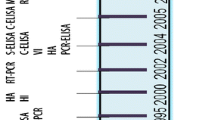Abstract
Rinderpest had been reported in most parts of Ethiopia when the Pan African Rinderpest Campaign (PARC) was launched. As a result of intensive disease investigation and strategic vaccination, most parts of the country are now considered provisionally free, and widespread vaccination has been replaced by clinical and serological surveillance. Details of any episodes of disease are recorded and followed up after laboratory confirmation of suspected cass using antigen-capture ELISA. This paper is based on observations on the performance of the antigen detection ELISA compared to the agar gel immunodiffusion (AGID) test, which also differentiates rinderpest from peste des petits ruminants (PPR). The stability of the specific viral antigen was monitored for 4 days, and rinderpest and PPR antigens were still detected, depending on the type of specimen. Antigen capture ELISA is more rapid, sensitive and virus specific than the AGID. Even if the cold chain of the specimen is compromised for a day or two during sample collection and submission, the specimen may still be suitable for testing by ELISA.
Similar content being viewed by others
REFERENCES
Abraham, G., 1994. Rinderpest disease and serological survey in Ethiopia. In: The Sero-monitoring of Rinderpest Throughout Africa: Phase II, IAEA-TECDOC-772, (International Atomic Energy Agency (IAEA), Vienna, Austria)
Barrett, T., Amarel-Doel, C., Kitching, R.P. and Gusev, A., 1993. Use of the polymerase chain reaction in differentiating rinderpest field virus and vaccine virus in the same animal. Revue Scientifique et Technique de l'Office International des Epizootie, 12, 865-872
Libeau, G. and Lefevre, P.C., 1990. Comparison of rinderpest and peste des petits ruminants viruss using anti-nucleoprotein monoclonal antibodies. Veterinary Microbiology, 25, 1-6
Libeau, G., Diallo, A., Colas, F. and Guerre, L., 1994. Rapid differential diagnosis of rinderpest and PPR using immuno-capture ELISA. The Veterinary Record, 134, 300-304
Mack, R., 1970. The great African cattle plague epidemic of the 1890s. Tropical Animal Health and Production, 2, 210-219
Pankhurst, R., 1985. The History of Famine and Epidemics in Ethiopia Prior to Twentieth Century, (Relief and Rehabilitation Commission, RRC, Addis Ababa, Ethiopia)
Roeder, P.L., Abraham, G., Kenfe, G. and Barrett, T., 1994. Peste des petits ruminants in Ethiopian goats. Tropical Animal Health and Production, 26, 69-73
Scott, G.R. and Brown, R.D., 1961. Rinderpest diagnosis with special reference to the agar gel double diffusion test. Bulletin of Epizootic Diseases of Africa, 9, 83-120
Wafula, J.S., Mirangi, P.K., Ireri, R.G. and Mbugua, N., 1986. Development and stability of rinderpest virus antigens in cattle tears and lymph nodes. Tropical Animal Health and Production, 18, 26-30
Wamwayi, H.M., Rossiter, P.B. and Wafula, J.S., 1991. Confirmation of rinderpest in experimentally and naturally infected cattle using microtitre techniques. Tropical Animal Health and Production, 23, 17-21
Author information
Authors and Affiliations
Rights and permissions
About this article
Cite this article
Abraham, G., Berhan, A. The Use of Antigen-capture Enzyme-linked Immunosorbent Assay (ELISA) for the Diagnosis of Rinderpest and Peste des Petits Ruminants in Ethiopia. Tropical Animal Health and Production 33, 423–430 (2001). https://doi.org/10.1023/A:1010547907730
Issue Date:
DOI: https://doi.org/10.1023/A:1010547907730




